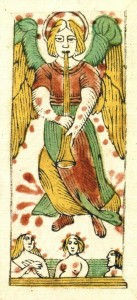This two-volume book considers tarot from every possible angle: popular culture, occult theory, academic history, literary analysis and artistic commentary. I hope my brief summary of the articles will inspire you to purchase this major contribution to tarot studies.
Volume I offers a good foundation in tarot history.
The late Sir Michael Dummett surveys tarot from its 15th-century beginnings as a card game, to its appropriation by French occultists in the late 18th century.
Robert Place delves deeply into the iconography of the earliest hand-painted decks and discusses the trump sequence as a neoplatonic ascent of the soul. He also describes the first set of trump cards we know of, by the Duke of Milan’s astrologer Marziano de Tortona, which Place is currently re-creating. (Examples can be seen on his facebook page.) Read more











